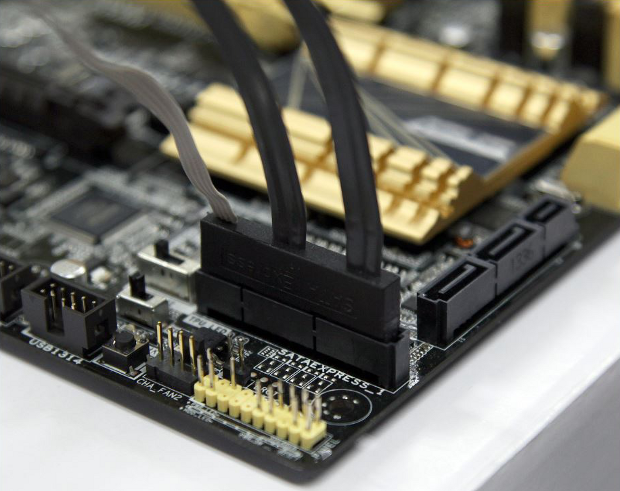Day two at Storage Visions finds us visiting the SATA-IO booth and talking to Paul Wassenberg. Paul is the Director of Product Marketing for Marvell, and also a SATA-IO board member. The Serial ATA International Organization (SATA-IO) is an independent, non-profit organization developed by and for leading industry companies for the purpose of providing the industry with guidance and support for implementing the SATA specification. Paul has been instrumental in moving the SATA Express interface and standard forward, and readying it for adoption by both client (individual user — as in PCs) storage device producers and client motherboard manufacturers. This creates an interface that provides storage speeds of greater than 6Gb/s to meet the needs of such users.
Image source: Asus
In order to achieve this at the client level, the logical choice was to work with the PCIe interface to overcome the SATA limitations of 6Gb/s. PCIe is a mature technology that continues to be refined and improved. The PCIe 3.0 revision facilitates the increase of a single PCIe lane’s speed to 1GB/s. More and more PCIe-interfaced storage products are being offered, as it allows for the ability to scale upward by merely adding more PCIe lanes.
SATA Express creates a standardized connection between a host and the legacy HDD-style form factors (predominantly the 2.5″ type). The SATA Express standard provides support for up to 2GB/s of performance by adding a second PCIe lane to the specification. This will encompass even the fastest current client SSDs, with additional room for growth.
SATA Express is pure PCIe. There is no SATA link or transport layer, so there’s no translation overhead – users realize the full performance of PCIe. Perhaps a good way to think about SATA Express is as the standardization of PCIe as an interface for client storage devices. The benefit of standards is that they create both interoperability and interchangeability, which means that devices from different manufacturers work together and can be interchanged with no loss of functionality. In this way, standards drive volume. To achieve these goals, SATA Express needs standard connectors and common operating system drivers.
SATA Express connectors are slightly modified standard SATA connectors and are mechanically compatible with today’s SATA connector. This plug-compatibility is important, as it enables SATA and PCIe to co-exist. The new host connector supports up to two SATA ports or up to two PCIe lanes. There is a separate signal, driven by the drive that tells the host if the device is SATA or PCIe, so the host knows what “language” to speak.
We are beginning to see motherboard manufacturers (such as ASRock, Gigabyte, MSI and ASUS) offer products that support SATA Express. These motherboards can have a single connector that supports a current SATA drive or PCIe drive. Drive manufacturers are also starting to develop drives that utilize the SATA Express interface, as well as NAND controller manufacturers (as in Marvell’s 88SS1083).
So what is the next step for SATA Express? It will likely follow the evolution of PCIe — once PCIe rev. 4.o comes out, this will double the bandwidth to 2GB/s. You can visit SATA-IO’s SATA Express technology page at their website here for more info.
Stay tuned for further developments as we wind up Storage Visions 2015 later today and begin visiting CES and its exhibitors tomorrow. We have a number of private meetings scheduled over the next three days, and will post what we find and learn as it happens.
 The SSD Review The Worlds Dedicated SSD Education and Review Resource |
The SSD Review The Worlds Dedicated SSD Education and Review Resource | 


Great post! Really informative! I am pretty bad with technology but want to learn !visit website